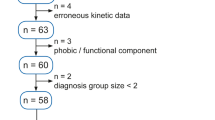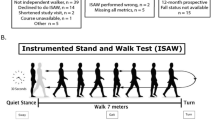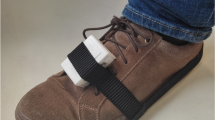Abstract
Background
The role of instrumented balance and gait assessment when screening for prospective fallers is currently a topic of controversial discussion.
Objectives
This study analyzed the association between variables derived from static posturography, instrumented gait analysis and clinical assessments with the occurrence of prospective falls in a sample of community dwelling older people.
Methods
In this study 84 older people were analyzed. Based on a prospective occurrence of falls, participants were categorized into fallers and non-fallers. Variables derived from clinical assessments, static posturography and instrumented gait analysis were evaluated with respect to the association with the occurrence of prospective falls using a forward stepwise, binary, logistic regression procedure.
Results
Fallers displayed a significantly shorter single support time during walking while counting backwards, increased mediolateral to anteroposterior sway amplitude ratio, increased fast mediolateral oscillations and a larger coefficient (Coeff) of sway direction during various static posturography tests. Previous falls were insignificantly associated with the occurrence of prospective falls.
Conclusion
Variables derived from posturography and instrumented gait analysis showed significant associations with the occurrence of prospective falls in a sample of community dwelling older adults.
Zusammenfassung
Hintergrund
Der Nutzen instrumenteller Gang- und Gleichgewichtsanalyse, zur Früherkennung von Stürzereignissen, wird aktuell kontrovers diskutiert.
Fragestellung
Untersucht wurde der Zusammenhang zwischen Variablen der statischen Posturographie, der instrumentellen Ganganalyse und klinischer Assessments mit dem Auftreten von Stürzereignissen, bei selbstständig lebenden älteren Personen.
Methoden
Basierend auf einem prospektiv aufgetretenen Sturz wurden 84 ältere Personen in „Stürzer“ und „Nichtstürzer“ klassifiziert. Variablen aus klinischen Assessments, der statischen Posturographie und der instrumentellen Ganganalyse wurden in Hinblick auf eine Assoziation mit prospektiven Stürzen evaluiert, dazu diente ein vorwärts schrittweises, binärer, logistisches Regressionsverfahren.
Ergebnisse
Stürzer zeigten eine signifikant kürzere monopedale Standphase bein Gehen und Rückwärtszählen, im Vergleich mit anterior-posterioren Schwankungen höheremedio-laterale Schwankungen, verstärkte schnelle mediolaterale Oszillationen und einen vergrößerten Koeffizient der Schwankungsrichtung während verschiedener statische posturographischer Tests. Frühere Stürzereignisse waren nicht signifikant assoziiert mit prospektiv erfassten Stürzen.
Diskussion
Variablen der statischen Posturographie und instrumenteller Ganganalyse zeigten bei selbstständig lebenden älteren Personen signifikante Assoziationen mit prospektiv erfassten Stürzen.
Similar content being viewed by others
References
Berry SD, Miller RR (2008) Falls: epidemiology, pathophysiology, and relationship to fracture. Curr Osteoporos Rep 6:149–154
Hill KD, Moore KJ, Dorevitch MI et al (2008) Effectiveness of falls clinics: an evaluation of outcomes and client adherence to recommended interventions. J Am Geriatr Soc 56:600–608
Gillespie LD, Robertson MC, Gillespie WJ et al (2012) Interventions for preventing falls in older people living in the community. Cochrane Database Syst Rev 9:CD007146
Kenny RAM, Rubenstein LZ, Tinetti ME et al (2011) Summary of the updated American Geriatrics Society/British Geriatrics Society Clinical Practice Guideline for prevention of falls in older persons. J Am Geriatr Soc 59:148–157
Kannus P, Sievanen H, Palvanen M et al (2005) Prevention of falls and consequent injuries in elderly people. Lancet 366:1885–1893
Berg K, Wood-Dauphinee S, Williams JI (1995) The balance scale: reliability assessment with elderly residents and patients with an acute stroke. Scand J Rehabil Med 27:27–36
Duncan PW, Weiner DK, Chandler J et al (1990) Functional reach: a new clinical measure of balance. J Gerontol 45:M192–M197
Applegate WB, Blass JP, Williams TF (1990). Instruments for the functional assessment of older patients. N Engl J Med 322:1207–1214
Kressig RW, Beauchet O, European GAITRite Network Group (2006) Guidelines for clinical applications of spatio-temporal gait analysis in older adults. Aging Clin Exp Res 18:174–176
Kressig RW, Herrmann FR, Grandjean R et al (2008) Gait variability while dual-tasking: fall predictor in older inpatients? Aging Clin Exp Res 20:123–130
Ruhe A, Fejer R, Walker B (2010) The test-retest reliability of centre of pressure measures in bipedal static task conditions—a systematic review of the literature. Gait Posture 32:436–445
Merlo A, Zemp D, Zanda E et al (2012) Postural stability and history of falls in cognitively able older adults: the Canton Ticino study Gait Posture 36:662–666
Nardone A, Schieppati M (2010) The role of instrumental assessment of balance in clinical decision making. Eur J Phys Rehabil Med 46:221–237
Bongue B, Dupré C, Beauchet O et al (2011) A screening tool with five risk factors was developed for fall-risk prediction in community-dwelling elderly. J Clin Epidemiol 64:1152–1160
Piirtola M, Era P (2006) Force platform measurements as predictors of falls among older people—a review. Gerontology 52:1–16
Folstein MF, Folstein SE, McHugh PR (1975) “Mini-mental state”: a practical method for grading the cognitive state of patients for the clinician. J Psychiatr Res 12:189–198
Sheikh JI, Yeswage JA (1986) Geriatrci depression scale (GDS): recent evidence and development of a shorter version. Clin Gerontol 5:165–173
Podsiadlo D, Richardson S (1991) The timed “Up and Go”: a test of basic functional mobility for frail elderly persons. J Am Geriatr Soc 39:142–148
Tinetti ME (1986) Performance oriented assessment of mobility problems in elderly patients. J Am Geriatr Soc 34:119–128
McCarthy EK, Horvat MA, Holtsberg PA et al (2004) Repeated chair stands as a measure of lower limb strength in sexagenarian women. J Gerontol Ser A-Biol Sci Med Sci 59:1207–1212
Davidson D, Eskridge J (1977) Reliability of visual acuity measures of amblyopic eyes. Am J Optom Physiol Opt 54:756–766
Lunetta M, Le Moli R, Grasso G et al (1998) A simplified diagnostic test for ambulatory screening of peripheral diabetic neuropathy. Diabetes Res Clin Pract 39:165–172
Lamb SE, Jørstad-Stein EC, Hauer K et al (2005) Development of a common outcome data set for fall injury prevention trials: the Prevention of Falls Network Europe consensus. J Am Geriatr Soc 53:1618–1622
van Uden C, Besser M (2004) Test-retest reliability of temporal and spatial gait characteristics measured with an instrumented walkway system (GAITRite(R)). BMC Musculoskelet Disord 5:13
Bauer C, Groeger I, Glabasnia A et al (2010) First results of the evaluation of a falls clinic. Int J Gerontol 4:130–136
Bauer C, Groeger I, Rupprecht R et al (2008) Intrasession reliability of force platform parameters in community-dwelling older adults. Arch Phy Med Rehabil 89:1977–1982
Murphy MA, Olson SL, Protas EJ et al (2003) Screening for falls in community-dwelling elderly. J Aging Phys Act 11:66–80
Paterson K, Hill K, Lythgo N (2011) Stride dynamics, gait variability and prospective falls risk in active community dwelling older women. Gait Posture 33:251–255
Liu H, McGee M, Wang W et al (2009) Comparison of gait characteristics between older rolling walker users and older potential walker users. Arch Gerontol Geriatr 48:276–280
Bridenbaugh SA, Kressig RW (2015) Motor cognitive dual tasking: early detection of gait impairment, fall risk and cognitive decline. Z Gerontol Geriatr 48:15–21
Author information
Authors and Affiliations
Corresponding author
Ethics declarations
Conflict of interest
C.M. Bauer, I. Gröger, R. Ruprecht, V.L. Marcar and K.G. Gaßmann declare that there no conflicts of interest.
The study was approved by the local ethics committee and was carried out in accordance with national law and the Helsinki Declaration of 1975 (in its current revised form). All participants signed informed consent prior to the study.
Electronic supplementary material
Rights and permissions
About this article
Cite this article
Bauer, C., Gröger, I., Rupprecht, R. et al. Prediction of future falls in a community dwelling older adult population using instrumented balance and gait analysis. Z Gerontol Geriat 49, 232–236 (2016). https://doi.org/10.1007/s00391-015-0885-0
Received:
Revised:
Accepted:
Published:
Issue Date:
DOI: https://doi.org/10.1007/s00391-015-0885-0




